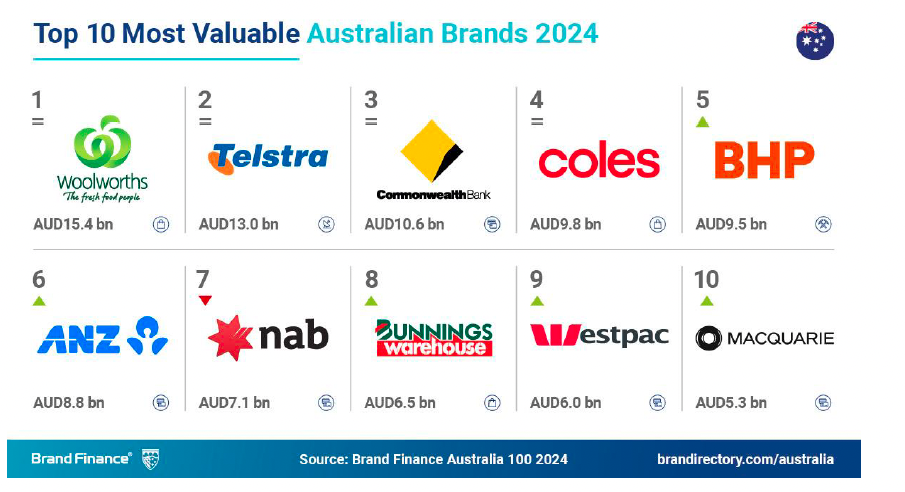More evidence B2B marketers – and sales – are flipping to brand amid performance reversal as next gen buying committees seek different set of creds

What you need to know:
- Dentsu’s 4th edition of its Superpowers Index finds the flip from performance to brand marketing for B2B firms is locked in – brand is now clearly more important in terms of future strategy than performance.
- That’s a position supported by the CMO of a major international software brand who says changes to the way things like search advertising work means that in future “everyone’s going to be a brand marketer.”
- The message in getting through down under where brands like Logicalis, part of a global operation, and Tracksuit, a homegrown brand are all in when it comes to their own marketing strategies
- The Superpower Index study also suggests that marketers seriously overestimate the regard in which their customers hold them and that buyers don’t see differentiation, but rather a sea of sameness.
- The number of buyers looking for brands that are ‘good for society’ has almost doubled in four years – from 14 to 25 per cent, while ‘good for business’ has fallen as a priority from 65 per cent in 2021 to 48 per cent today. That’s despite a global pandemic and an economic slowdown that might have been expected to drive a flight to certainty and safety. More likely according to dentsu, safety means something new to the emerging cohort of buyers.
- Loss rates for incumbents are also on the rise, increasing from 29 per cent last year to 34 per cent now.
- And buyers are eliminating vendors much earlier in the buying journey, with 30 per cent of brands already knocked out of the game, before they even knew they were on the field.
Even if we have all the other conversion numbers stay the same, if we just increase awareness by 1 per cent that translates more than a million dollars in pipeline."
Lara Barnett, head of marketing in Australia for the global technology-managed service provider Logicalis has done the research, run the numbers and can stamp a dollar value onto the impact of brand spend. Courtesy of a brand study and the data that has fallen out of it, she has calculated that assuming all other factors remain equal, a tiny increase in awareness translates into a very healthy pipeline.
“Even if we have all the other conversion numbers stay the same, if we just increase awareness by 1 per cent that translates into more than a million dollars in pipeline.”
Armed with the data, and with the support of the executive leadership team, and importantly, buy-in from sales, Barnett has reallocated money away from performance and into brand.
“The key is time,” she tells Mi3. “It doesn’t happen overnight, and B2B can have a really long buying cycle. And for us as a business, it can be exceptionally long, anywhere from 12 to 18 months.”
Not that you will have to wait that long for results to emerge, as Mikayla Hopkins, head of marketing at brand tracking platform Tracksuit – which tracks B2C brands – recently told Mi3. In its own marketing, Tracksuit relies heavily on content marketing such as toolkits and case studies, and she urged her Australian peers in B2B to extend the attribution window to really understand the impact of content marketing.
There is also plenty of evidence about the efficacy of brand in platform data.
According to Henry Innis, cofounder, and CEO of econometrics platform Mutinex, “Commonly what we see across GrowthOS (the Mutinex platform) is that brand marketing delivers incremental return far higher than what can be seen in conventional last-click attribution, which is not really a form of marketing attribution but sales attribution.”
“For context, a market mix model will consider all actions and activities as contributing to an overall sales trend, rather than trying to isolate sales to a specific sales channel like multi-touch attribution (which arguably is more about sales touchpoints than anything.”
He said B2B companies looking to actually deliver incremental growth need to invest in measuring incrementality, rather than playing at the edges of sales attribution. “Without it, their growth typically flatlines, budgets have to work harder for increasingly expensive inventory and growth becomes harder to achieve in competitive and often commoditized categories. It really is that simple.”
“At Mutinex, we also eat our own dog food on this, having proven out brand marketing ourselves and seen it work. Performance channels deliver very little of our actual volume without brand marketing, so I’m all in on the channel both as someone who sees the results at scale and someone who spends a significant B2B marketing budget, ” he said.
Despite the growing weight of evidence, marketers in the Australian tech sector, traditionally, have been notorious for their reliance on performance marketing, but that is now changing according to research, and marketers like Barnett are at the vanguard of that change.
“The best time to start was a year ago and the second best time is today,” she says.
The latest proof point of the growing primacy of brand in B2B marketing comes from the fourth annual Superpowers index from dentsu B2B (previously Merkle). This year the issue of ‘raising brand awareness/top of funnel performance’ is now ranked first based on the importance to future strategy. It was fifth last year and sixth in 2021.
Contrast that with ‘demand generation/driving and converting leads’ which has fallen to seventh place this year. It was fourth last year and third in each of 2022 and 2021.
According to the report, “It’s no surprise to see the intent from B2B marketers to invest in brand. Lead gen has come under increasing fire; brand has momentum. The influence of lobbying from LinkedIn, concepts like the 95/5 rule, research from Ehrenberg-Bass and others all add to a strong case for brand investment.”
The conclusions in the dentsu Superpowers Study layer on further evidence of the B2B shift to brand.
Green Hat’s APAC B2B Buyer Journey Research Report 2024 – which polled 733 B2B buyers across Australia, New Zealand, Hong Kong, Singapore and South East Asia, found that buyers are typically 73 per cent into their journey before the point of first contact with a vendor and that buyers initiate first contact with sellers 78 per cent of the time. Which strongly suggests B2B’s historic obsession with marketing qualified leads isn’t working. Otherwise those stats would be flipped.
“There’s not enough on building brand,” says Green Hat MD, Stuart Jaffray. “When you look at the fact that nine and a half months of this journey is done anonymously, unknown to us, and it’s largely where information being gathered – brand building and brand awareness is key during that stage. Buyers know what they’re shopping for, they want to buy from someone that they think they can trust and they want to be able to compare them.”
A Bain-backed study by LinkedIn-funded think tank The B2B Institute meanwhile found that “hidden buyers” influence half of the buying process and have very different requirements from target buyers. They don’t care about features, it’s all about downside risk management.
B2B Institute founder, Jann Martin Schwarz, is certain that if B2B marketers flip legacy models and target the entire buying group, it will rapidly deliver tens of billions of dollars in dealmaking upside. And in a market-level echo of Lara Barnett’s company-focused calculations, Schwarz pointed out that a one per cent improvement on $18.7 trillion is upwards of $180bn in annual unlocked deals.
“I’m willing to stake my reputation as a B2B marketing thinker on the fact that if you successfully reach the whole buyer group, if you reach hidden buyers, just as well as target buyers, you will see an immediate spike in activity that will allow you to close more deals faster,” Schwarz told Mi3 in late July.
In terms of the dentsu study, one of the areas it explored to describe the growing pull of brand was the overall influence of decision drivers on B2B purchase decisions.
The report notes that for the first time, personal decision drivers outweigh profession ones. Although that trend has been baked-in for several years, it has accelerated in the last 12 months. The report’s authors argue that this finding should add fuel to the call for more creativity, storytelling and emotional resonance in B2B – something the B2B Institute has long argued. Its 2022 study of 600 B2B ad campaigns found 71 per cent were highly unlikely to deliver any sales because they tended to use the same formula: lots of text, a voiceover and a logo at the end.

According to Denstu’s B2B’s APAC President Kiaran Geen, “We’ve been talking to our clients about this for the last three years, because it has been moving up and up. The buying committees and the choices were quite linear. It’s like, ‘Oh, this is my job. I need to make sure I’m doing the best thing for my job.’ “
That’s now changing.
Woke or broke?
“What we’re seeing in the numbers is that people are much more socially conscious than they ever have. So for me to succeed in my workplace, I have to choose a brand that is safe. And that’s not ‘will the product perform?’ It’s actually ‘will we look good as a brand by engaging in this brand?’ That’s where a lot of this is coming from, and it was a substantial leap.”
Geen told Mi3, “If you look at the broader context of what’s going on in the world, we are much more socially aware, and we only want to work with brands that make us in the world feel good. This is a really good watershed moment. There are not many B2B brands that focus on their behaviour in society as a key selling point.”
If that sounds dangerously woke, and almost an inversion of “No one ever got fired for buying IBM”, then think again.
“In the sea of sameness, you’ve got to make sure that you have every weapon your brand has [at its disposal] to actually be successful in that sales cycle, because it is brutal out there.”
Sam Cunliffe, MD of dentsu B2B ANZ, added, “We talk about the fact that the buying group is expanding as well, so there are a lot more people involved in that decision group, including a lot more diverse opinions and behaviours. That overall buying cohort requires a lot more different ingredients.”
There’s also a generational imperative, Geen suggests. “Buying committees are getting younger as well. There’s simply no other way to say it – Gen X is now the minority. Younger people are a lot more socially aware than some of the previous cohorts.”
Closing the circle on the last two months of new data on B2B marketing intentions, dentsu B2B’s VP strategy and solutions, Jake Hird, referenced the most recent Bain-backed LinkedIn study. “The LinkedIn research talks about the fear of messing up, which is a very mature driver. Again, it’s not about the business having a fear of missing out on a product or a service, generally. It’s the fear of messing up as an individual.
“Some of those personal drivers are things like safety, for example, ‘I want to feel safe signing a contract’. ‘I want the supplier to teach me new skills and knowledge to make me better at my job’. It’s basically the fear of messing up.”
Which means B2B marketers flogging features and benefits are probably wasting their time.
But brand marketers also have to have a realistic sense of what their brand represents, Geen said,
The Superpowers study for instance found that while 71 per cent of marketers rate their performance highly when it comes to communicating a distinct brand position or strong USP, buyers fell they are swimming in a sea of sameness. It’s not so much, IBM Blue as industry beige. 68 per cent of buyers agreed with the statement, “Many of the brands I see at work have very similar marketing and communications messages – they all sound and act the same.”
Everybody's going to be a brand marketer over the next decade, because direct response traffic sources are going to go down, by and large.
Distribution or perception constraints?
There are other factors at play, says Kipp Bodnar, the CMO of Hubspot, a software-as-a-service platform provider whose customers include marketers. Bodnar’s job involves assessing budget pitches and the all-important split (especially in IT) between performance and brand
Perhaps more importantly, as a global tech marketer, he focuses deeply on the details of his customers’ marketing challenges in a world where old digital advertising certainties are unwinding with the rise of generative AI and its impact on, for instance, search marketing.
“Everybody’s going to be a brand marketer over the next decade because direct response traffic sources are going to go down, by and large,” he told Mi3. “That’s not a surprise – and you’re seeing this early glimpse of large language models.”
Marketers are starting to understand that while they may be showing up in large language models, they are not getting the traffic back to their site, and attribution is becoming harder. “All of those things become much more challenging.”
As to where best to allocate marketing dollars, Bodnar makes the argument that most companies are distribution-constrained, not product-constrained. “That means they’re they’ve got a good product, they just can’t get that product to market.”
“If you are a high transaction volume business, I think you actually really are a distribution business and [looking at] performance marketing, direct response. As you move up the average sale price spectrum, you become perception-constrained, right? Do people trust you? Do people think you’re a credible, scalable solution, all of those things? I think if the business has a high transaction volume and a low average sale price, you can go a long time just on performance marketing – probably the first 10 years, your business probably works great there.
“But the second you kind of go above that $5k a year kind of investment, you start becoming perception constrained.”
When that happens Bodnar says it’s time to align the leadership around those perception constraints.
“What are the core objections? With our brand marketing, it’s not just like we want people to know our company name. Instead, we’re going to address that core perception challenge in the market with brand marketing in a very clear, deliberate campaign strategy.”
Do that well and you will rapidly move the needle, he suggests. “We’ve seen very quick changes in the data and in the results. Within six months you can make massive changes – if you are very clear on the problem and very focused on the problem.”
Misunderstanding
Shah Ghaffurian, the CEO and co-founder of Melbourne-based media agency Magic acknowledged the trends towards brand highlighted in the dentsu study.
“I think the reality is it’s always been really important, it just hasn’t been well understood.”
“All these businesses had lead gen KPIs and basically pushed all marketing to the bottom of the funnel; there was no incentive to invest in brand. But what’s been happening over the last five years is all of these companies that are very obviously focusing on that [brand] as a core output, their share prices are going up, their revenues going up, and then every other B2B business is looking at these guys while their growth is relatively flat, and asking themselves what the hell are they doing differently?” says Ghaffurian.
“They are starting to clue into the fact that Brand might be more important.”
As to points of resistance – or reluctance to change – he points at sales. “Sales teams want a number of leads to work with each given month, this pipeline of leads gets attributed through digital media, or performance media, and there’s this fear that if you turn that off, then those leads will disappear, so that’s the core resistance.”
Which means KPIs for both marketing and sales need to be re-engineered, which ladders up to the CFO and CEO.
Engaging sales
Back at Logicalis, Barnett has done the hard yards of bringing management and other divisions on side. The process involved underlining why brand matters, simple ideas like the Ehrenberg-Bass developed 95/5 rule – that most of your customers are not in the market at any given time but you need to build awareness for when they are.
“Our sales team has been very aligned, and that’s a really positive reaction. I think that’s because they are at the coalface. They have the toughest job of anyone and they actually are seeing the fact that the customers might not be as aware of us as they they would want them to be,” says Barnett.
Sales have been the most encouraging, in a way, because they actually see it out in the market. They’ll say, ‘You know what? Not enough customers are aware of us’.”
“That is our optimisation point. For another company it could be something else, maybe everyone’s aware of them, but no one actually prefers them. But for us, it’s the awareness. And after customers are aware, then they’re actually really quite engaged and likely to consider us,” she says.
Barnett has a new brand campaign in market which should prove that point one way or another.





